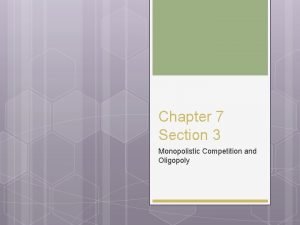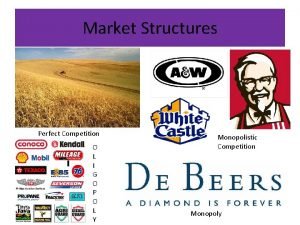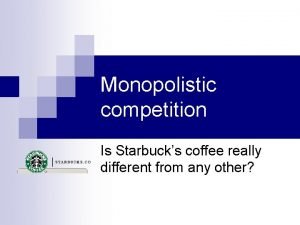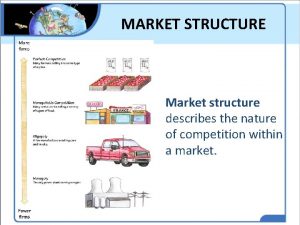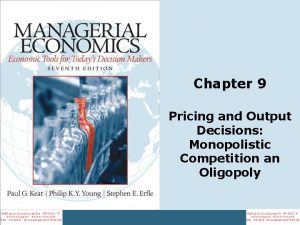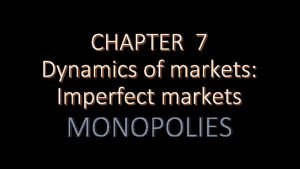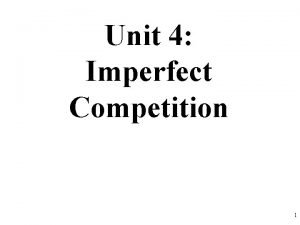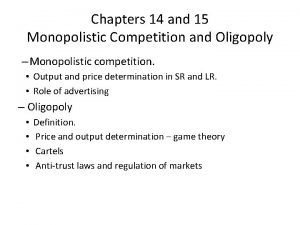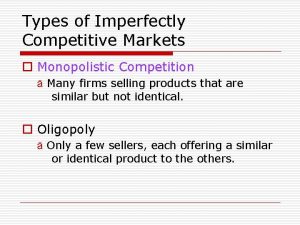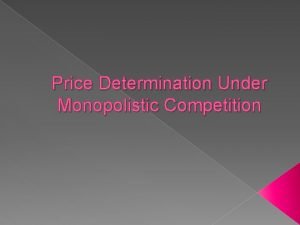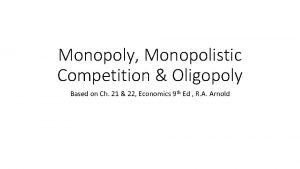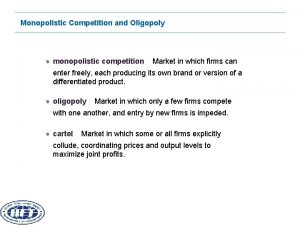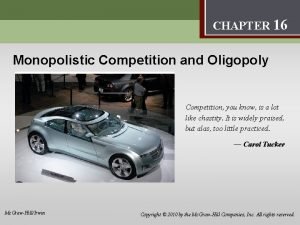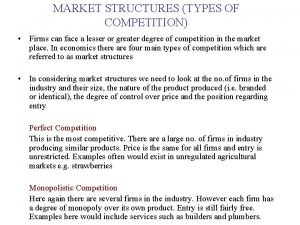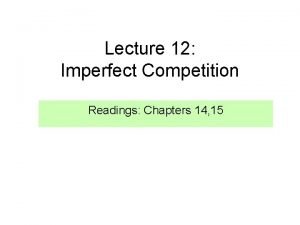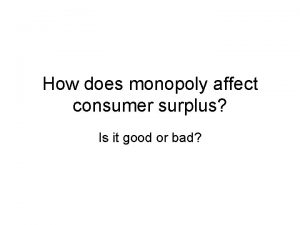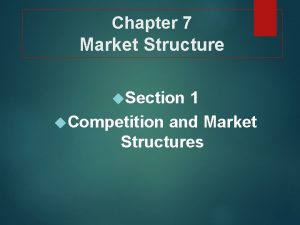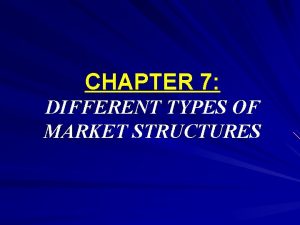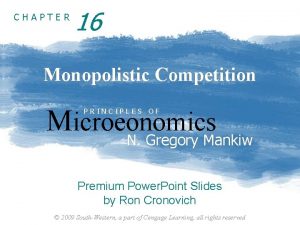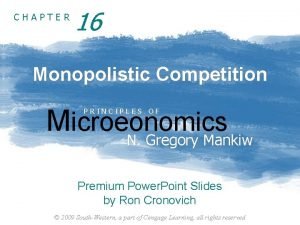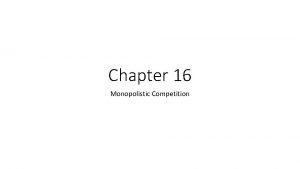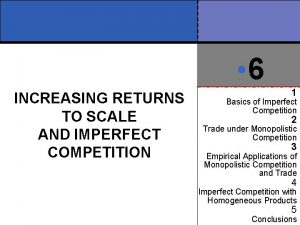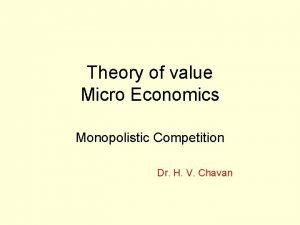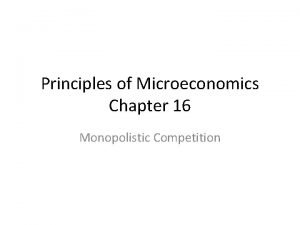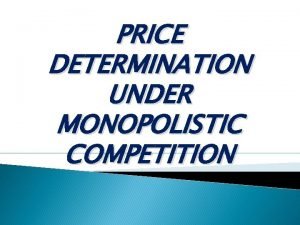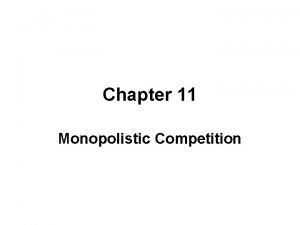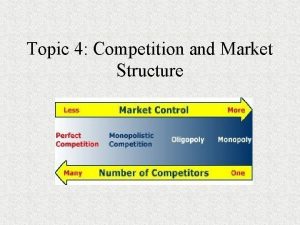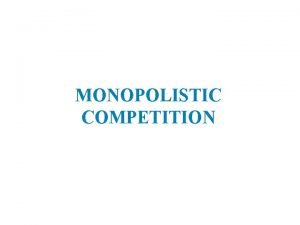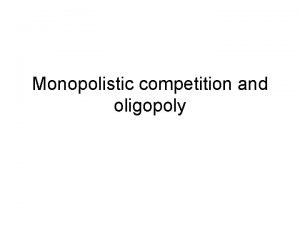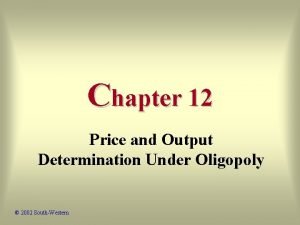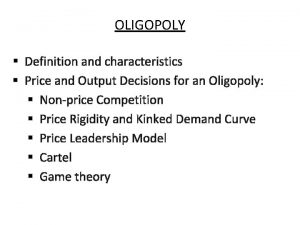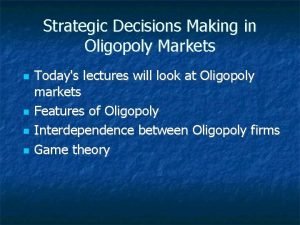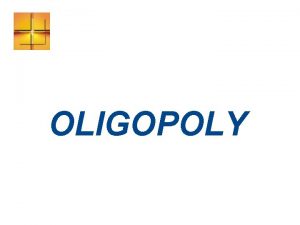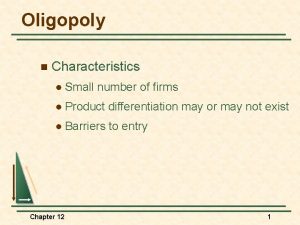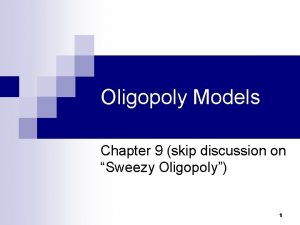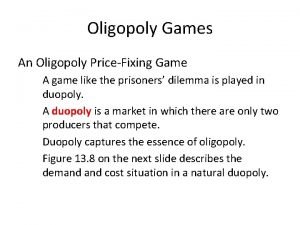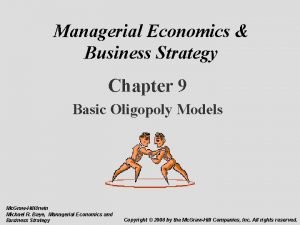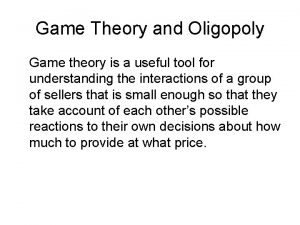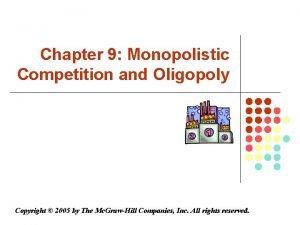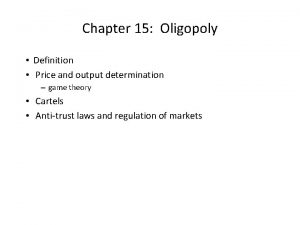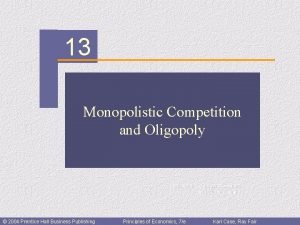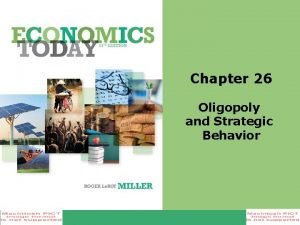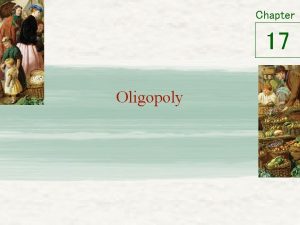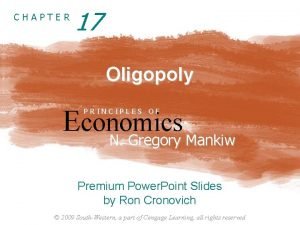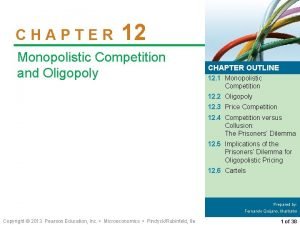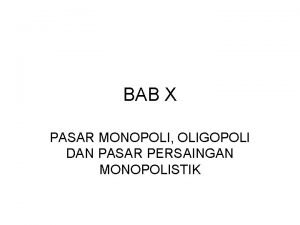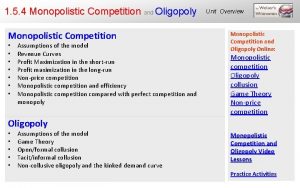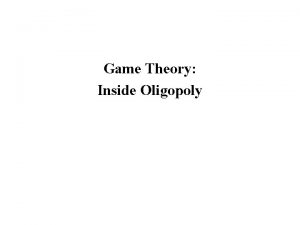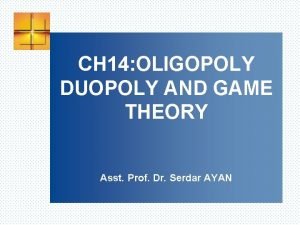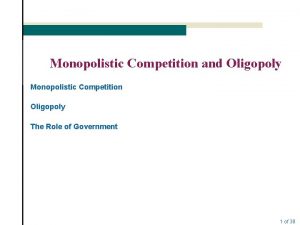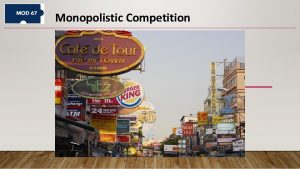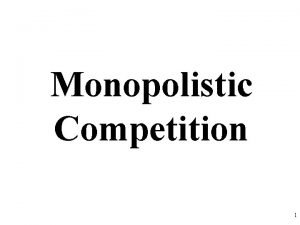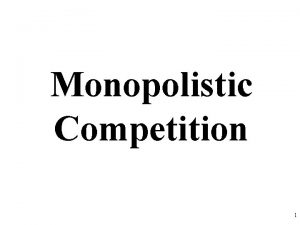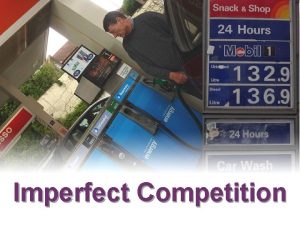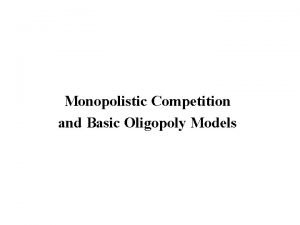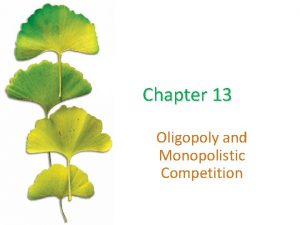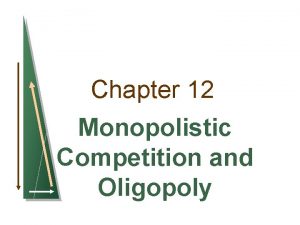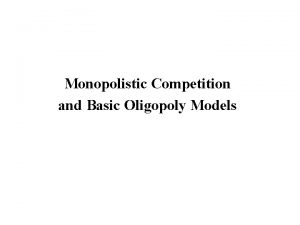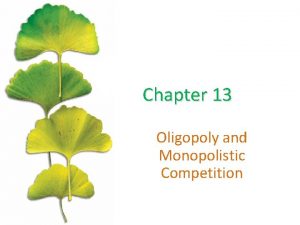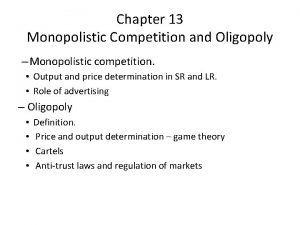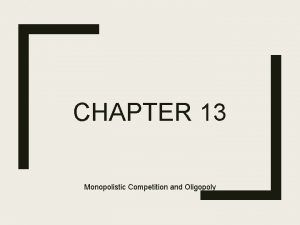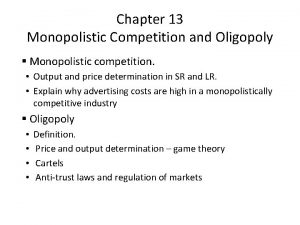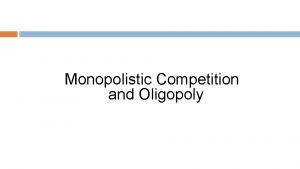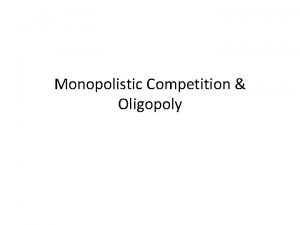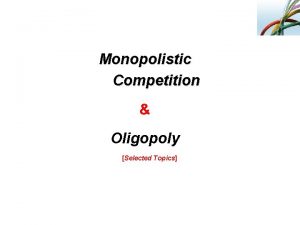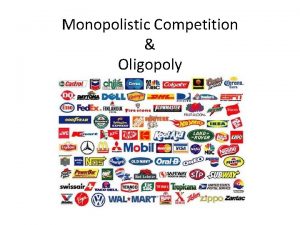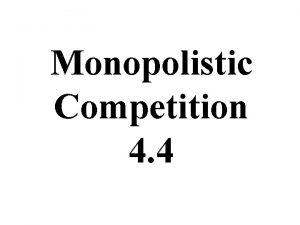Oligopoly and Monopolistic Competition Sample Questions AP Economics






























































- Slides: 62

Oligopoly and Monopolistic Competition Sample Questions AP Economics Mr. Bordelon

Oligopoly is a market structure characterized by a. independence in decision making. b. regulated natural monopolies. c. substantial diseconomies of scale. d. a large number of small firms. e. uncertainty about the behavior of rival firms.

Oligopoly is a market structure characterized by a. independence in decision making. b. regulated natural monopolies. c. substantial diseconomies of scale. d. a large number of small firms. e. uncertainty about the behavior of rival firms.

Collusive agreements are typically difficult for cartels to maintain because each firm can increase profits by: a. secretly reporting the collusion to the federal government. b. producing less output than the quantity that maximizes joint cartel profits. c. increasing the price above the price that maximizes joint cartel profits. d. engaging in less advertising than the level of advertising that maximizes joint cartel profits. e. producing more output than the quantity that maximizes joint cartel profits.

Collusive agreements are typically difficult for cartels to maintain because each firm can increase profits by: a. secretly reporting the collusion to the federal government. b. producing less output than the quantity that maximizes joint cartel profits. c. increasing the price above the price that maximizes joint cartel profits. d. engaging in less advertising than the level of advertising that maximizes joint cartel profits. e. producing more output than the quantity that maximizes joint cartel profits.

Gadget Demand Schedule Price Quantity Demanded $10 0 9 100 8 200 7 300 6 400 5 500 4 600 3 700 2 800 1 900 0 1000 The market for gadgets is dominated by two producers, Margaret and Ray. Each firm can produce gadgets at marginal costs of approximately zero dollars. The table shows the market demand schedule for gadgets and the total revenue of the industry at each point on the market demand curve. If these two producers acted independently to maximize profit, total industry output would be _____. If these two producers formed a cartel and acted to maximize total industry profits, total industry output would be _____. a. 5 gadgets; 10 gadgets b. 0 gadgets; 5 gadgets c. 100 gadgets; 50 gadgets d. 1, 000 gadgets; 500 gadgets e. 1, 000 gadgets; 100 gadgets

Gadget Demand Schedule Price Quantity Demanded $10 0 9 100 8 200 7 300 6 400 5 500 4 600 3 700 2 800 1 900 0 1000 The market for gadgets is dominated by two producers, Margaret and Ray. Each firm can produce gadgets at marginal costs of approximately zero dollars. The table shows the market demand schedule for gadgets and the total revenue of the industry at each point on the market demand curve. If these two producers acted independently to maximize profit, total industry output would be _____. If these two producers formed a cartel and acted to maximize total industry profits, total industry output would be _____. a. 5 gadgets; 10 gadgets b. 0 gadgets; 5 gadgets c. 100 gadgets; 50 gadgets d. 1, 000 gadgets; 500 gadgets e. 1, 000 gadgets; 100 gadgets

In an oligopolistic market structure, collusion between firms usually leads to higher profits than noncooperative behavior. Which of the following statements accurately describes why formal, overt collusion doesn’t usually occur in the United States? I. Formal collusion is illegal. II. There is an incentive for each firm to cheat on a collusive agreement. III. Oligopolistic industries have low barriers to entry. a. I only b. II only c. III only d. I and II only e. I, II and III

In an oligopolistic market structure, collusion between firms usually leads to higher profits than noncooperative behavior. Which of the following statements accurately describes why formal, overt collusion doesn’t usually occur in the United States? I. Formal collusion is illegal. II. There is an incentive for each firm to cheat on a collusive agreement. III. Oligopolistic industries have low barriers to entry. a. I only b. II only c. III only d. I and II only e. I, II and III

Overt collusion exists if: a. the government regulates an industry such that firms must charge a price equal to marginal cost. b. smaller firms in an industry learn to charge the same price as the largest firm. c. competition among a large number of small firms generates a stable market price. d. competition among a large number of small firms generates similar, but slightly different, prices. e. firms agree openly on price, output, and other decisions aimed at achieving monopoly profits.

Overt collusion exists if: a. the government regulates an industry such that firms must charge a price equal to marginal cost. b. smaller firms in an industry learn to charge the same price as the largest firm. c. competition among a large number of small firms generates a stable market price. d. competition among a large number of small firms generates similar, but slightly different, prices. e. firms agree openly on price, output, and other decisions aimed at achieving monopoly profits.

Engaging in price competition or Bertrand behavior will most likely mean oligopolists: a. cannot increase their level of output quickly due to limits on their productive capacity. b. will likely increase price to monopoly levels. c. will likely collude effectively in order to produce the joint profit-maximizing quantity. d. will end up behaving like a monopolist. e. will likely end up behaving like a perfectly competitive industry.

Engaging in price competition or Bertrand behavior will most likely mean oligopolists: a. cannot increase their level of output quickly due to limits on their productive capacity. b. will likely increase price to monopoly levels. c. will likely collude effectively in order to produce the joint profit-maximizing quantity. d. will end up behaving like a monopolist. e. will likely end up behaving like a perfectly competitive industry. Okay, I double checked this question, and the test bank states B, but I believe this to be a typo given the question. Checking with my notes, the textbook and another colleague, the answer should be B…next slide…

Bertrand Model. Based on price competition. Oligopolists engage in tit-for-tat behavior and will do so until P = MC, the perfectly competitive outcome. Cournot Model. Based on quantity competition. Oligopolists only produce the quantity that will maximize profit given the fixed output of others. This would cause lower output and higher prices, giving each firm a positive economic profit. Similar to monopoly prices. This is why I think the question above had a typo. I think it’s referencing the Cournot Model, not Bertrand.

Jake and Zoe are the only producers of slushes in Vacatown. Each week, each firm decides whether to price high or price low for the following week. The figure shows the profit per week earned by the two firms. What is the Nash equilibrium for Jake and Zoe? a. Jake prices high; Zoe prices high b. Jake prices high; Zoe prices low c. Jake prices low; Zoe prices high d. Jake prices low; Zoe prices low e. This game does not have a Nash equilibrium.

Jake and Zoe are the only producers of slushes in Vacatown. Each week, each firm decides whether to price high or price low for the following week. The figure shows the profit per week earned by the two firms. What is the Nash equilibrium for Jake and Zoe? a. Jake prices high; Zoe prices high b. Jake prices high; Zoe prices low c. Jake prices low; Zoe prices high d. Jake prices low; Zoe prices low e. This game does not have a Nash equilibrium.

Every week, each firm decides whether to price high or price low for the following week. The figure shows the profit per week earned by the two firms. Suppose the firms each decide to price high initially, and adopt a titfor-tat strategy for the following weeks. After a few weeks, how much profit would each firm make per week? a. Jake’s profit = $800; Zoe’s profit = $800. b. Jake’s profit = $1, 000; Zoe’s profit = $1, 000 c. Jake’s profit = $1, 500; Zoe’s profit = $200 d. Jake’s profit = $200; Zoe’s profit = $1, 500 e. Jake’s profit = $900; Zoe’s profit = $900

Every week, each firm decides whether to price high or price low for the following week. The figure shows the profit per week earned by the two firms. Suppose the firms each decide to price high initially, and adopt a titfor-tat strategy for the following weeks. After a few weeks, how much profit would each firm make per week? a. Jake’s profit = $800; Zoe’s profit = $800. b. Jake’s profit = $1, 000; Zoe’s profit = $1, 000 c. Jake’s profit = $1, 500; Zoe’s profit = $200 d. Jake’s profit = $200; Zoe’s profit = $1, 500 e. Jake’s profit = $900; Zoe’s profit = $900

In the classic prisoners’ dilemma with two accomplices in crime, the dominant strategy for each individual is to: a. never confess. b. always confess. c. confess only if the other confesses. d. This game does not have a dominant strategy. e. confesss only if the other does not confess.

In the classic prisoners’ dilemma with two accomplices in crime, the dominant strategy for each individual is to: a. never confess. b. always confess. c. confess only if the other confesses. d. This game does not have a dominant strategy. e. confesss only if the other does not confess.

In the classic prisoners’ dilemma with two accomplices in crime, the Nash equilibrium is for: a. both individuals to not ocnfess. b. both individuals to confess. c. the first player to confess and the second player to not confess. d. This game does not have a Nash equilibrium. e. the first player to not confess and the second player to confess.

In the classic prisoners’ dilemma with two accomplices in crime, the Nash equilibrium is for: a. both individuals to not confess. b. both individuals to confess. c. the first player to confess and the second player to not confess. d. This game does not have a Nash equilibrium. e. the first player to not confess and the second player to confess.

Tacit collusion in practice is made more difficult to achieve: a. the larger the number of firms in the industry. b. the fewer the number of products being sold. c. the more similar the marginal costs of each firm. d. if customers have little or no bargaining power. e. the less differentiated the products being sold.

Tacit collusion in practice is made more difficult to achieve: a. the larger the number of firms in the industry. b. the fewer the number of products being sold. c. the more similar the marginal costs of each firm. d. if customers have little or no bargaining power. e. the less differentiated the products being sold.

Suppose that each of two firms has the independent choice of advertising its product or not advertising. If neither advertises, each gets $10 million in profit; if both advertise, their profits will be $5 million each; and if one advertises while the other does not, the advertiser gets profit of $15 million while the other gets profit of $2 million. According to game theory, if the firms could collude to maximize profit: a. both may or may not advertise. b. firm 1 will advertise and firm 2 will not advertise. c. both will advertise. d. neither will advertise. e. firm 1 will not advertise and firm 2 will advertise.

Suppose that each of two firms has the independent choice of advertising its product or not advertising. If neither advertises, each gets $10 million in profit; if both advertise, their profits will be $5 million each; and if one advertises while the other does not, the advertiser gets profit of $15 million while the other gets profit of $2 million. According to game theory, if the firms could collude to maximize profit: a. both may or may not advertise. b. firm 1 will advertise and firm 2 will not advertise. c. both will advertise. d. neither will advertise. e. firm 1 will not advertise and firm 2 will advertise.

The Orlando theme-park industry tends to follow a price leadership model. This means that: a. each theme park sets its own price and operating hours independent of what other parks do. b. Disney, the largest firm, often sets a price and rival theme parks then following with similar, if not identical, prices. c. Disney, the largest firm, often sets prices only to be undercut by rival firms who prefer to engage in price wars. d. in written agreements each firm explicitly agrees to charge identical prices. e. the government dictates specific prices and all firms are obligated to follow.

The Orlando theme-park industry tends to follow a price leadership model. This means that: a. each theme park sets its own price and operating hours independent of what other parks do. b. Disney, the largest firm, often sets a price and rival theme parks then following with similar, if not identical, prices. c. Disney, the largest firm, often sets prices only to be undercut by rival firms who prefer to engage in price wars. d. in written agreements each firm explicitly agrees to charge identical prices. e. the government dictates specific prices and all firms are obligated to follow.

Two firms have tacitly colluded on price-setting for several years. If this tacit agreement breaks down, it is likely to trigger a(n): a. Justice Department investigation. b. antitrust prosecution. c. price war. d. elimination of advertising expenditures. e. increase in combined profits.

Two firms have tacitly colluded on price-setting for several years. If this tacit agreement breaks down, it is likely to trigger a(n): a. Justice Department investigation. b. antitrust prosecution. c. price war. d. elimination of advertising expenditures. e. increase in combined profits.

Which of the following would make it difficult for oligopolists to collude? a. There are few firms in the market. b. There are few buyers in the market. c. The oligopolists have similar costs of production. d. Oligopolists usually produce a homogeneous product. e. There are substantial barriers to entry in the market.

Which of the following would make it difficult for oligopolists to collude? a. There are few firms in the market. b. There are few buyers in the market. c. The oligopolists have similar costs of production. d. Oligopolists usually produce a homogeneous product. e. There are substantial barriers to entry in the market.

Non-price competition is more prevalent in an oligopoly in which there is (are): a. a Nash equilibrium. b. complex products c. tacit price collusion. d. no product differentiations. e. a very inelastic demand curve.

Non-price competition is more prevalent in an oligopoly in which there is (are): a. a Nash equilibrium. b. complex products c. tacit price collusion. d. no product differentiations. e. a very inelastic demand curve.

Antitrust policy refers to government: a. attempts to prevent the acquisition of monopoly power. b. attempts to encourage the exercise of monopoly power. c. encouragement of collusion in the marketplace. d. attempts to limit private enterprise. e. attempts to promote research and development.

Antitrust policy refers to government: a. attempts to prevent the acquisition of monopoly power. b. attempts to encourage the exercise of monopoly power. c. encouragement of collusion in the marketplace. d. attempts to limit private enterprise. e. attempts to promote research and development.

A major application of the Sherman Antitrust Act was in _____ against _____. a. 1880; the Ford Motor Company b. 1984; AT&T c. 1911; Standard Oil d. 1948; Paramount Pictures e. 1990; Microsoft

A major application of the Sherman Antitrust Act was in _____ against _____. a. 1880; the Ford Motor Company b. 1984; AT&T c. 1911; Standard Oil d. 1948; Paramount Pictures e. 1990; Microsoft

Suppose a monopolistically competitive firm can increase its profits by decreasing its output. Then it must be the case that at the current output: a. marginal revenue is less than zero. b. price is less than marginal revenue. c. price is less than marginal cost. d. price is less than average total cost. e. marginal revenue is less than marginal cost.

Suppose a monopolistically competitive firm can increase its profits by decreasing its output. Then it must be the case that at the current output: a. marginal revenue is less than zero. b. price is less than marginal revenue. c. price is less than marginal cost. d. price is less than average total cost. e. marginal revenue is less than marginal cost.

Suppose a monopolistically competitive firm can increase its profits by increasing output. Then it must be the case that at the current output: a. marginal revenue is greater than marginal cost. b. price is less than marginal cost. c. price is less than average total cost. d. marginal revenue is less than marginal cost. e. price is equal to marginal revenue and marginal cost.

Suppose a monopolistically competitive firm can increase its profits by increasing output. Then it must be the case that at the current output: a. marginal revenue is greater than marginal cost. b. price is less than marginal cost. c. price is less than average total cost. d. marginal revenue is less than marginal cost. e. price is equal to marginal revenue and marginal cost.

The monopolistic competitor in the figure is producing at the output level that maximizes profits (minimizes losses). The shaded rectangle depicts the level of: a. profit. b. loss. c. fixed cost. d. variable cost. e. total cost.

The monopolistic competitor in the figure is producing at the output level that maximizes profits (minimizes losses). The shaded rectangle depicts the level of: a. profit. b. loss. c. fixed cost. d. variable cost. e. total cost.

If monopolistically competitive firms are earning positive economic profits in the short run, then in the long run: a. firms will leave the industry. b. the demand curves faced by existing firms will move to the right. c. economic profits will increase. d. economic profits will be reduced to zero. e. the average total cost curve will shift upward.

If monopolistically competitive firms are earning positive economic profits in the short run, then in the long run: a. firms will leave the industry. b. the demand curves faced by existing firms will move to the right. c. economic profits will increase. d. economic profits will be reduced to zero. e. the average total cost curve will shift upward.

Assume that the market for gas stations is characterized by many firms, differentiated products, easy entry, and easy exit. The typical gas station shown in the figure will maximize profits at a quantity of: a. Q 1 b. Q 2 c. Q 3 d. P 1 e. 0.

Assume that the market for gas stations is characterized by many firms, differentiated products, easy entry, and easy exit. The typical gas station shown in the figure will maximize profits at a quantity of: a. Q 1 b. Q 2 c. Q 3 d. P 1 e. 0.

The figure shows curves facing a typical gas station in a large town. Assume that the market is characterized by many firms, diffentiated products, easy entry, and easy exit. If the gas station here is typical of others in the community, then in the long run, we would expect to observe: a. a few gas stations exiting the market. b. new gas stations entering the market. c. neither entry nor exit. d. the government regulating gas stations so that prices are lower for consumers. e. many gas stations choosing to shut down.

The figure shows curves facing a typical gas station in a large town. Assume that the market is characterized by many firms, diffentiated products, easy entry, and easy exit. If the gas station here is typical of others in the community, then in the long run, we would expect to observe: a. a few gas stations exiting the market. b. new gas stations entering the market. c. neither entry nor exit. d. the government regulating gas stations so that prices are lower for consumers. e. many gas stations choosing to shut down.

In the long run, perfect competitors and monopolistic competitors are similar in that they: a. set price where MR < MC. b. produce an output level at which P = ATC. c. produce a product that is standardized and hard to differentiate. d. earn a positive economic profit. e. set price where MR = MC = ATC.

In the long run, perfect competitors and monopolistic competitors are similar in that they: a. set price where MR < MC. b. produce an output level at which P = ATC. c. produce a product that is standardized and hard to differentiate. d. earn a positive economic profit. e. set price where MR = MC = ATC.

Two firms, Firm A and Firm B, have identical cost curves, yet Firm A operates in perfect competition and Firm B operates in monopolistic competition. In the long run, what can we say about the price and output that each firm charges? a. Firm A’s price will be lower than Firm B’s price, and Firm A’s output will be lower than Firm B’s output. b. Firm A’s price will be greater than Firm B’s price, and Firm A’s output will be greater than Firm B’s output. c. Firm A’s price will be greater than Firm B’s price, and Firm A’s output will be lower than Firm B’s output. d. Firm A’s price will be lower than Firm B’s price, and Firm A’s output will be greater than Firm B’s output. e. Firm A’s price will be lower than Firm B’s price, and Firm A’s output will be equal to Firm B’s output.

Two firms, Firm A and Firm B, have identical cost curves, yet Firm A operates in perfect competition and Firm B operates in monopolistic competition. In the long run, what can we say about the price and output that each firm charges? a. Firm A’s price will be lower than Firm B’s price, and Firm A’s output will be lower than Firm B’s output. b. Firm A’s price will be greater than Firm B’s price, and Firm A’s output will be greater than Firm B’s output. c. Firm A’s price will be greater than Firm B’s price, and Firm A’s output will be lower than Firm B’s output. d. Firm A’s price will be lower than Firm B’s price, and Firm A’s output will be greater than Firm B’s output. e. Firm A’s price will be lower than Firm B’s price, and Firm A’s output will be equal to Firm B’s output.

In the long run, monopolistically competitive firms produce less than the output at which average total cost is minimized. This is referred to as: a. irrational capacity. b. excess capacity. c. product differentiation. d. zero economic profit. e. price leadership.

In the long run, monopolistically competitive firms produce less than the output at which average total cost is minimized. This is referred to as: a. irrational capacity. b. excess capacity. c. product differentiation. d. zero economic profit. e. price leadership.

Because monopolistically competitive firms charge a P > MC: a. monopolistic competition is efficient. b. monopolistic competition is inefficient. c. the marginal benefit to society of an additional unit of output is below its cost. d. monopolistic competition is inefficient and the marginal benefit to society of an additional unit of output is below its cost. e. deadweight loss does not exist in monopolistic competition.

Because monopolistically competitive firms charge a P > MC: a. monopolistic competition is efficient. b. monopolistic competition is inefficient. c. the marginal benefit to society of an additional unit of output is below its cost. d. monopolistic competition is inefficient and the marginal benefit to society of an additional unit of output is below its cost. e. deadweight loss does not exist in monopolistic competition.

A large shopping mall has a food court with many different restaurants serving many different cuisines to hungry shoppers. By offering so many different choices to customers, the food court is practicing product differentiation by: a. brand name. b. price. c. quality. d. style and type. e. location.

A large shopping mall has a food court with many different restaurants serving many different cuisines to hungry shoppers. By offering so many different choices to customers, the food court is practicing product differentiation by: a. brand name. b. price. c. quality. d. style and type. e. location.

Which of the following advertising slogans provides information to potential buyers? a. Coffee Palace—Stop and smell the coffee! b. Karaoke Maker wants you to just sing it! c. Bee’s Beachside Restaurant is the only restaurant on the beach for 50 miles. d. The Happy Hotel has a happy bed for you. e. Patty’s Pies: mmmmmmm pie!

Which of the following advertising slogans provides information to potential buyers? a. Coffee Palace—Stop and smell the coffee! b. Karaoke Maker wants you to just sing it! c. Bee’s Beachside Restaurant is the only restaurant on the beach for 50 miles. d. The Happy Hotel has a happy bed for you. e. Patty’s Pies: mmmmmmm pie!
 Chapter 7 section 3 monopolistic competition and oligopoly
Chapter 7 section 3 monopolistic competition and oligopoly Pure competition advertising
Pure competition advertising Why is starbucks monopolistic competition
Why is starbucks monopolistic competition Advantage of monopolistic competition
Advantage of monopolistic competition Lump sum subsidy monopoly
Lump sum subsidy monopoly Perfect competition vs monopolistic competition
Perfect competition vs monopolistic competition Monopoly vs oligopoly venn diagram
Monopoly vs oligopoly venn diagram Competition refers to
Competition refers to Difference between monopoly and monopolistic competition
Difference between monopoly and monopolistic competition Market structure
Market structure Difference between monopoly and monopolistic competition
Difference between monopoly and monopolistic competition Dynamics of imperfect market
Dynamics of imperfect market Advantages and disadvantages of monopolistic competition
Advantages and disadvantages of monopolistic competition Characteristics of monopolistic competition
Characteristics of monopolistic competition Non price competition in oligopoly
Non price competition in oligopoly How to find excess capacity on a graph
How to find excess capacity on a graph Mr=mc monopoly
Mr=mc monopoly Price and output determination under monopoly
Price and output determination under monopoly Consumer surplus in monopolistic competition
Consumer surplus in monopolistic competition Monopolistic competition price
Monopolistic competition price Demand curve in oligopoly
Demand curve in oligopoly Monopolistic competition in long run
Monopolistic competition in long run Monopolistic competition short run
Monopolistic competition short run Consumer surplus in a monopoly
Consumer surplus in a monopoly What is a monopolistic competition example
What is a monopolistic competition example Monopolistic competition companies examples
Monopolistic competition companies examples Monopolistic competition characteristics
Monopolistic competition characteristics Conclusion
Conclusion Monopolistic competition long run
Monopolistic competition long run Monopolistic competition
Monopolistic competition Monopolistic competition short run
Monopolistic competition short run Chapter 16 monopolistic competition
Chapter 16 monopolistic competition How is price determined under monopolistic competition
How is price determined under monopolistic competition Feature of monopoly
Feature of monopoly Monopolistic competition def
Monopolistic competition def How to find excess capacity on a graph
How to find excess capacity on a graph Conclusion of monopolistic competition
Conclusion of monopolistic competition Monopolistic competition example
Monopolistic competition example Oligopoly questions
Oligopoly questions Economics and business economics maastricht
Economics and business economics maastricht Price and output determination under oligopoly
Price and output determination under oligopoly Oligopoly definition
Oligopoly definition What is mathematical economics
What is mathematical economics Example of oligopoly market structure
Example of oligopoly market structure Oligopoly characteristics
Oligopoly characteristics Oligopoly characteristics
Oligopoly characteristics Sweezy oligopoly example
Sweezy oligopoly example Oligopoly game theory matrix
Oligopoly game theory matrix Stackelberg oligopoly model
Stackelberg oligopoly model Oligopoly game theory matrix
Oligopoly game theory matrix Example of oligopoly market structure
Example of oligopoly market structure Price fixing definition
Price fixing definition Oligopoly game theory matrix
Oligopoly game theory matrix Oligopoly summary
Oligopoly summary Chapter 17 oligopoly
Chapter 17 oligopoly Chapter 17 oligopoly
Chapter 17 oligopoly Cartel microeconomics
Cartel microeconomics Kurva pasar monopoli
Kurva pasar monopoli Oligopoly demand curve
Oligopoly demand curve Game theory inside oligopoly
Game theory inside oligopoly Chapter 17 oligopoly
Chapter 17 oligopoly Uber oligopoly
Uber oligopoly Oligopoly board game
Oligopoly board game
